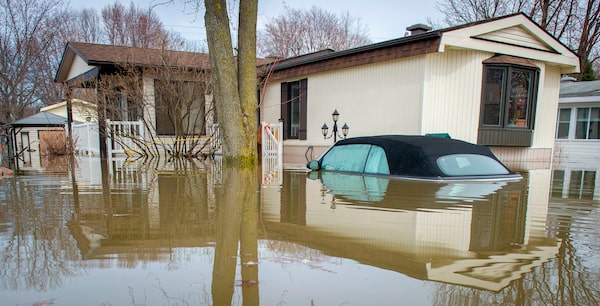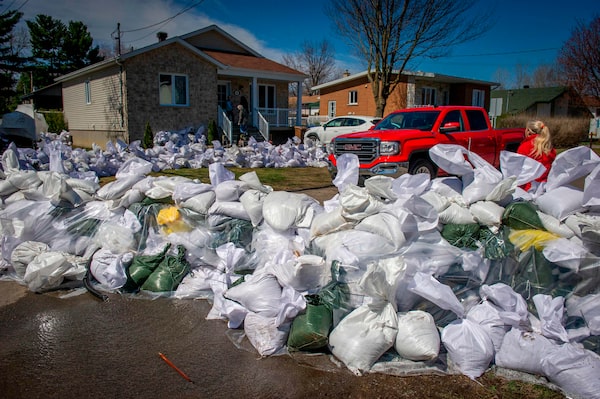
An automobile is submerged in flood waters in the Montreal suburb of Sainte-Marthe-sur-le-Lac, Que., on April 29, 2019.SEBASTIEN ST-JEAN/AFP/Getty Images
As floodwaters crest in most of Eastern Canada’s flood zones, the Quebec government is warning stricken residents that the province’s lakes and rivers may take weeks to return to their usual water levels.
Workers and homeowners maintaining flood fortifications will have to remain on alert well into May, with record-breaking water levels and flows. Several bodies of water were to crest Tuesday and, in the Ottawa region, by Wednesday. But more rain was in the forecast for Wednesday, complicating flood prediction.
Premier François Legault warned it could be two weeks before most houses are out of the flood zone. Public Security Minister Geneviève Guilbault added that the 10,149 evacuees from 6,681 flooded homes need to prepare for the long haul.
“The receding of the water all over Quebec is going to be very slow,” Ms. Guilbault said in her daily briefing in Quebec City. “I want to prepare people, to tell them to arm themselves with patience.”
A broken dike that prompted the emergency evacuation of 6,500 people in Sainte-Marthe-sur-le-Lac on the weekend added to the urgency to reinforce several hot spots in Gatineau, the western suburbs of Montreal and along the Ottawa River system, where berms and sandbags hold floodwaters back from thousands of vulnerable but dry homes.

Quebec Premier François Legault warned it could be two weeks before most houses are out of the flood zone.SEBASTIEN ST-JEAN/AFP/Getty Images
Water is still rising in some pockets. Some 300 residents fled to higher ground Monday in Pontiac, Que., west of Ottawa, after officials became concerned about the integrity of two dikes and worked through the day to reinforce them.
Michel Lacerte spent Monday hauling sandbags to the dike in Pointe-Calumet, just up from Sainte-Marthe, where authorities have been on high alert for more than a week. His stone two-storey house would have 1.3 metres of water in it if not for the earthen dike, he said.
“We’re breathing a little easier, but the risk remains,” Mr. Lacerte said. “We’ve got the army, tons of volunteers, and it’s holding nicely so far.”
The suburbs of the west end of Montreal Island were among the hardest hit in the 2017 flood. While 2019 has eclipsed that flood for water levels, river flows and overall damage in Quebec, communities such as Pierrefonds-Roxboro and Île-Bizard spent two years planning and acquiring equipment and, as a result, have only a few dozen homes with minor flooding.
“We had over 750 houses flooded in 2017, and now the water is higher and we have 50 to 60 homes flooded and 12 people evacuated,” said Pierrefonds-Roxboro Mayor Jim Beis. “We’ve done well until now.”
Still, a vast array of flood barriers protecting thousands of houses over almost six kilometres of waterfront, already tested by rushing waters and winds, remains under 24-hour surveillance.

Water is still rising in some pockets.SEBASTIEN ST-JEAN/AFP/Getty Images
“Two nights ago the winds and waves pounded one particular dike. At one point we pulled out our staff,” Mr. Beis said. “But the next day we went back with staff and military to build another level of protection. This is going on constantly. These dikes are under pressure and could break at any time, but so far so good.”
In one neighbourhood of nearby Île-Bizard, several residents who built dikes around their houses in 2017 banded together to build a single 500-metre dike that was holding Monday. After volunteers got the defence started, public servants from the city have come in to offer reinforcement. “It wasn’t a top-down thing, it is a total collaborative effort,” said Marc-Boris St-Maurice, who was helping protect the home of his parents, who are in their 70s.
In the Beauce, the region south of Quebec City where the floods hit first, the cleanup was well under way. In Sainte-Marie-de-Beauce, there was a giant, growing pile of soaked construction material and furniture in the town centre Monday.
Mr. Legault visited Lac Saint Pierre in the Trois-Rivières region to strike a hopeful note to one stricken place: “Here, we can say the worst is behind us.”
He reiterated, though, that flooded residents and the province as a whole will have to take a long, hard look at what should be reconstructed in low-lying communities that face the chronic threat of flood.
Conditions in New Brunswick’s flooded communities, which were battered by heavy downpours, high winds and thunderstorms over the weekend, were improving “by the hour” throughout the day Monday, according to Greg MacCallum, director of the New Brunswick Emergency Measures Organization.

Workers and homeowners maintaining flood fortifications will have to remain on alert well into May.SEBASTIEN ST-JEAN/AFP/Getty Images
Flanked at a morning news conference by National Defence Minister Harjit Sajjan and provincial Public Safety Minister Carl Urquhart, Mr. MacCallum warned residents to “remain vigilant” and not to expect waters to recede quickly despite a bout of good weather.
“It’s going to be gradual for a few days before we return to normal levels,” he said, adding: “We’re in a situation that’s regularly improving as hours go by.”
Several hundred members of the Canadian Armed Forces, including reservists, have moved into flood zones in Ontario, Quebec and New Brunswick. Mr. Sajjan said they will remain “as long as we’re needed.” While the military is legally entitled to cost reimbursement from provinces, it has not sought money in a decade. “We will not be doing cost recovery,” Mr. Sajjan said.
Mr. Urquhart said it is “too early to say” what kind of compensation will be made available for flood victims or what changes ought to be made to mitigate the damage of flooding.
“This is going to be common,” he said. “The Premier has said we’ve got to look … to make changes for the future. We definitely know something has to be done.”
As of Monday morning, at least 445 households and 1,111 people had voluntarily been evacuated, according to Bill Lawlor, the provincial director of the Canadian Red Cross.






